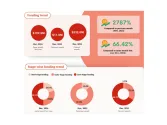
Show, don’t tell: Asian banks need to prove simplification works – here’s how
By Nicole ZhouThe choice is clear: simplify or stagnate — the future of Asian banking depends on it.
Asia’s economic engine is a powerhouse, attracting investors and institutions to the region’s dynamic markets. However, beneath the glittering skyscrapers of Singapore and the bustling trading floors of Hong Kong, a silent challenge is brewing within the banking sector: a productivity issue that threatens to derail the region’s growth.
The fast-paced and competitive environment in Asia demands a radical solution: simplification at scale. This isn’t about minor tweaks; it’s a fundamental rethinking of how banks operate, from the boardroom to the back office.
The productivity paradox: Why complexity is impacting Asian banks
For decades, Asian banks have relied on established systems, complex processes, and sprawling organisational structures. These elements have become a double-edged sword, making it difficult to maintain high productivity and foster innovation.
It’s time to move beyond surface-level adjustments. Asian banks need to adopt a more thorough simplification strategy, which includes divesting from underperforming assets, streamlining decision-making, and empowering their workforce to thrive in the digital age.
The numbers speak for themselves. Across the region, banks are struggling to maintain profitability due to rising operating costs and increasing regulatory burdens.
Traditional strategies, such as cost-cutting initiatives and incremental process improvements, have not been enough. The main issue is not just inefficiency; it’s a lack of agility and the inability to adapt quickly to changing market conditions.
Simplification can help by enabling banks to scrutinise their business and calculate the ROI for various functions, processes, and segments, much like a discerning investor.
Simplification: The strategic imperative for competitive advantage
Simplification is more than just a cost-cutting exercise; it’s a strategic imperative. Banks that can streamline their operations, reduce complexity, and deliver a seamless customer experience will dominate the Asian market.
This involves making tough choices, such as divesting from non-core businesses and consolidating overlapping functions. It also means adopting agile methodologies and empowering employees to make decisions quickly and efficiently.
Consider the typical customer in Southeast Asia trying to navigate a bank’s antiquated mobile app. Multiple logins, confusing menus, and a clunky user interface are common.
This isn’t just a customer service issue; it’s a productivity drain, as bank employees spend countless hours helping customers navigate these convoluted systems. The solution is a relentless focus on customer experience.
Banks must design their products and services around the needs of their customers, not their internal processes. This means investing in user-friendly mobile apps, simplifying account opening procedures, and providing personalised customer service. Leveraging data analytics to understand customer behaviour and identify areas for improvement is also crucial.
Harnessing technology and talent for a digital revolution
Asian banks have significant advantages, including a vast talent pool and a thriving technology sector. These resources can be harnessed to build simpler, more efficient operations.
Banks should embrace cutting-edge solutions like cloud computing, artificial intelligence, and robotic process automation. These technologies can automate routine tasks, enhance data analysis, and improve customer service.
However, technology alone isn’t the answer. Banks must also invest in their workforce, equipping employees with the skills and training needed to excel in the digital age.
This means fostering a culture of continuous learning, where employees are encouraged to experiment with new technologies and develop new skills. Attracting and retaining top talent by offering competitive salaries, benefits, and career advancement opportunities is equally important.
Tailored simplification: Navigating Asia’s diverse markets
Simplification is not a one-size-fits-all solution. The diverse cultural and regulatory landscapes across Asia require a nuanced approach.
What works in Singapore may not work in Indonesia, and vice versa. Banks must carefully consider the specific needs and challenges of each market when designing their simplification strategies. They must also be sensitive to cultural nuances and ensure that their solutions are culturally appropriate.
The concept of the “aggregation of marginal gains” is key. Banks should break down their operations into small components, improving each piece by just 1%, and achieving a significant compound effect in performance.
Instead of attempting to overhaul entire systems at once, banks should focus on making small, incremental improvements that add up over time. This approach minimises risk and allows banks to learn from their mistakes along the way.
It’s about fostering a culture of continuous improvement, where employees are constantly looking for ways to enhance efficiency and reduce complexity.
Real-world success: Lessons from HSBC and Citigroup
Let’s look at some real-world examples. HSBC’s refocusing on core regions like the United Kingdom and Hong Kong highlights the importance of concentrating resources on areas of strength.
Citigroup’s recent streamlining of its retail banking operations to focus on more lucrative areas such as wealth management is another compelling case. These examples show the value of simplification in enhancing focus and maximising profitability.
The journey to simplification won’t be easy. It will require strong leadership, a clear vision, and a willingness to challenge the status quo. But the rewards are significant.
Banks that embrace simplification will be better positioned to compete in the rapidly evolving Asian market, deliver a superior customer experience, and achieve sustainable growth. Asian banks must simplify to scale and unlock a productivity boost that will drive the region’s economic growth for decades to come.
Reimagining branches: From cost centres to customer hubs
Banks in Asia should re-evaluate their branch networks. As customers increasingly turn to digital channels, the need for physical branches is decreasing.
Banks can reduce costs by closing underperforming branches and consolidating their operations. This doesn’t mean eliminating branches altogether but optimising their network to better serve customer needs. Branches can be transformed into advisory centres, where customers receive personalised financial advice.
Simplification is an ongoing process of continuous improvement. Banks must continuously monitor their operations and seek ways to enhance efficiency and reduce complexity.
This requires a culture of continuous improvement, where employees are empowered to identify problems and propose solutions. Banks must also invest in technology and data analytics to track their progress and measure the impact of their simplification efforts.
Beyond simplification: A holistic approach to banking transformation
Embrace open banking and cybersecurity: Open banking initiatives, which allow customers to securely share their financial data with third-party providers, can drive innovation and competition. Asian banks should actively participate in open banking ecosystems, leveraging APIs to create new products and services and improve the customer experience.
As banks become more technology-dependent, cybersecurity becomes even more critical, banks must invest in robust cybersecurity measures to protect themselves and their customers from cyber threats.
Promote financial inclusion and regulatory compliance: Many people in Asia, particularly in rural areas, still lack access to basic banking services. Asian banks should work to promote financial inclusion by expanding their reach to underserved communities, offering affordable banking products, and leveraging technology to overcome geographical barriers.
Regulatory compliance is a constant challenge, especially in Asia, where regulations can vary significantly from country to country. Banks must invest in compliance technology and processes to ensure they meet all regulatory requirements.
Sustainability and ESG: Investors and customers are increasingly demanding that banks operate in a sustainable and socially responsible manner. Asian banks should integrate environmental, social, and governance (ESG) factors into their business strategies and operations.
This includes reducing their carbon footprint, promoting diversity and inclusion, and supporting local communities. By demonstrating a commitment to sustainability, banks can attract investors, improve their reputation, and contribute to a more sustainable future.
The future is now: Simplify or stagnate
The simplification journey is an ongoing process of continuous enhancement. Asian banks must embrace a culture of agility, innovation, and customer-centricity to stay ahead in a rapidly evolving financial landscape. Those that do will be well-positioned to thrive in the age of disruption and drive sustainable growth for years to come.
The choice is clear: simplify or stagnate. The future of Asian banking depends on it.
Banks must move beyond the theory of simplification and adopt a practical, results-oriented approach that delivers real business value. They must start showcasing concrete use cases and the tangible benefits they bring.
By embracing simplification, Asian banks can unlock significant productivity gains, improve profitability, and deliver exceptional customer experiences, ultimately driving economic growth and prosperity across the region. This is about unlocking new opportunities for growth, innovation, and customer satisfaction.
It’s time to show, not just tell, how simplification can transform the future of the banking industry in Asia.



















 Advertise
Advertise










